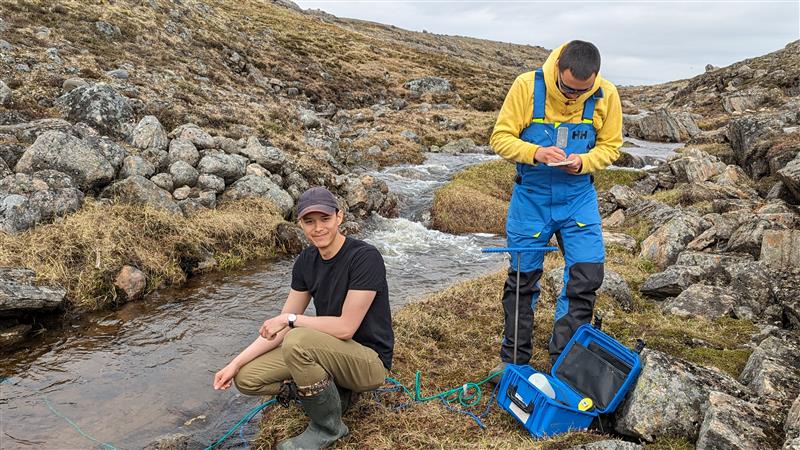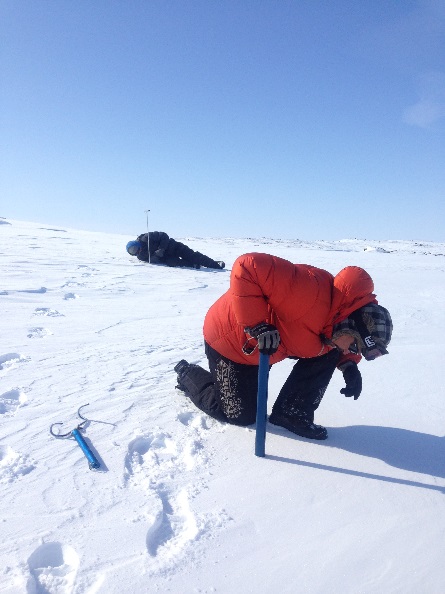Partnership for integrated hydrological monitoring, research, and training, in the Apex River watershed
Since approximately 2015 Nunavut Arctic College has collaborated with researchers from Carleton and Queen’s Universities to conduct hydrological research in the Niaqungut (Apex) River watershed. Annual research activities include measurement and modelling of water quality and quantity, with a major focus on accurate determination of the annual, end-of-winter snow accumulation with intensive ground-based surveys.
Each April, snow surveys are conducted by Environmental Technology Program students over the course of 3-5 days to quantify the landscape snow water equivalent or SWE (the amount of water stored in snowpack on the landscape) prior to the spring melt period. Automated measurement of snowfall amounts is particularly challenging in Arctic tundra landscapes due to high winds, making it important to measure the end of winter SWE on the ground. These data can be used to accurately track year-to-year changes in annual snowfall, which accounts for about half of the annual precipitation in this region, and its potential longer-term changes in response to climate warming. This partnership aims to build capacity for long-term SWE monitoring and to continue this important observation record for years to come, in support of water balance assessment and water security initiatives in the community of Iqaluit.
The research team also monitors freshwater quality of the Niaqungut River throughout open water period (from June until September). This work involves sampling river water for dissolved organic carbon and nitrogen, total nitrogen and phosphorous, and major anions and cations. At one nearby lake, water quality and zooplankton sampling was conducted in early July and in late September just prior to freeze-up. Zooplankton samples are enumerated for both total biomass and species composition, and measured for total mercury content. These data will be used to understand seasonal and inter-annual variability in surface water quality regimes and how they are influenced by hydrologic processes and change. Our goal is to continue these sampling efforts as part of a longer-term monitoring issue, in combination with hydrometric gauging and annual, end-of-winter snow surveys.
In 2017, funds were received from Polar Knowledge Canada to install a new micrometeorology station approximately 4 km from the community of Iqaluit, including a state-of-the-art Eddy Covariance (EC) system for measuring water, energy and carbon dioxide exchange over the tundra ecosystem. The EC system is currently operational and is filling an important data gap for this region of Canada’s eastern Arctic.
Rindy Hinanik Measures snow depth in the Niaqungut watershed using a snow coring tube (April, 2016)
Microbial water quality in Iqaluit streams and lakes
Since 2009 the NRI has also been tracking the amount of indicator bacteria (Total Coliforms and Escherichia coli) present in Iqaluit area lakes and streams including Niaqunngut River during the open water period. ETP students collect water samples at drinking water collection locations important to Iqalungmiut and then test the samples at the NRI's water lab in Iqaluit using defined substrate technology (Colilert by IDEXX) which allows for rapid and reliable detection of total coliforms and E. coli in surface waters. ETP students learn valuable laboratory and field based research skills while collecting information that is helping us assess whether the microbial quality of important local water sources is changing over time as our city's population grows and land based activities intensify in our watersheds. We are also hoping to better understand both the timing of seasonal peak loads of bacteria in rivers, and how factors such as river discharge, water temperature, and organic carbon might influence bacteria levels.
For more information on the water monitoring project, please contact NRI's Director, Innovation and Research.

NRI students Tyler Kowalchuk (left) and Zachary Carpenter (Right) collect water samples from Niaqungut river headwaters in 2023


